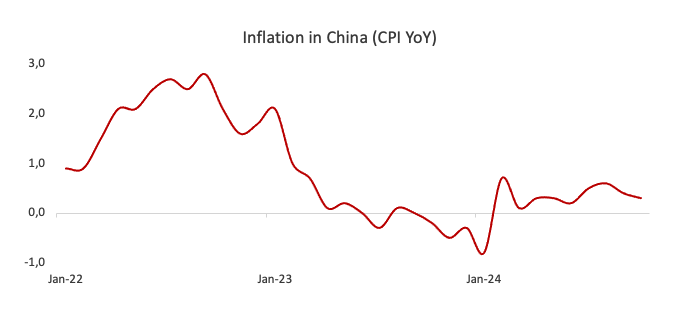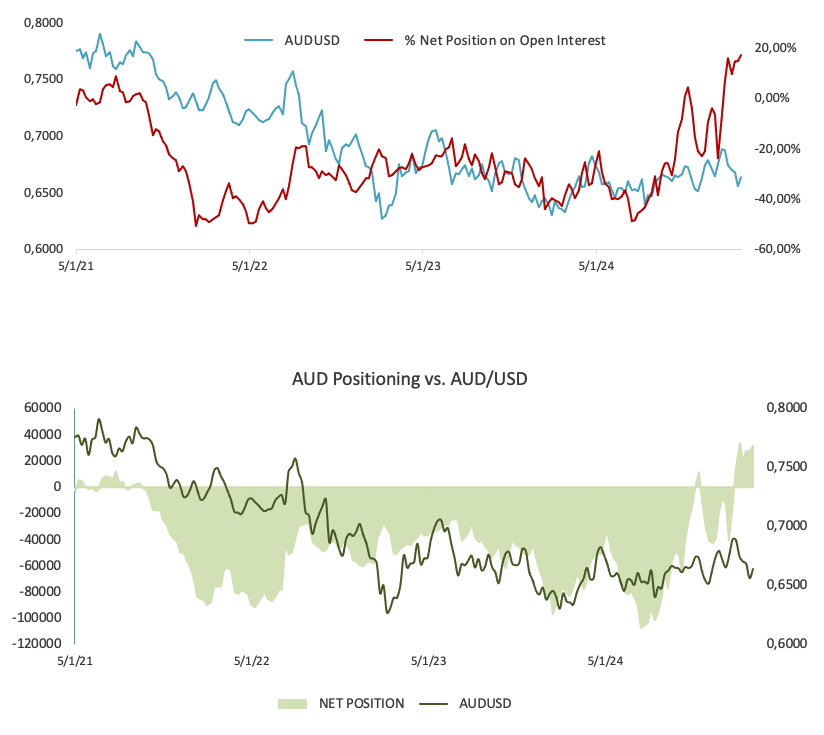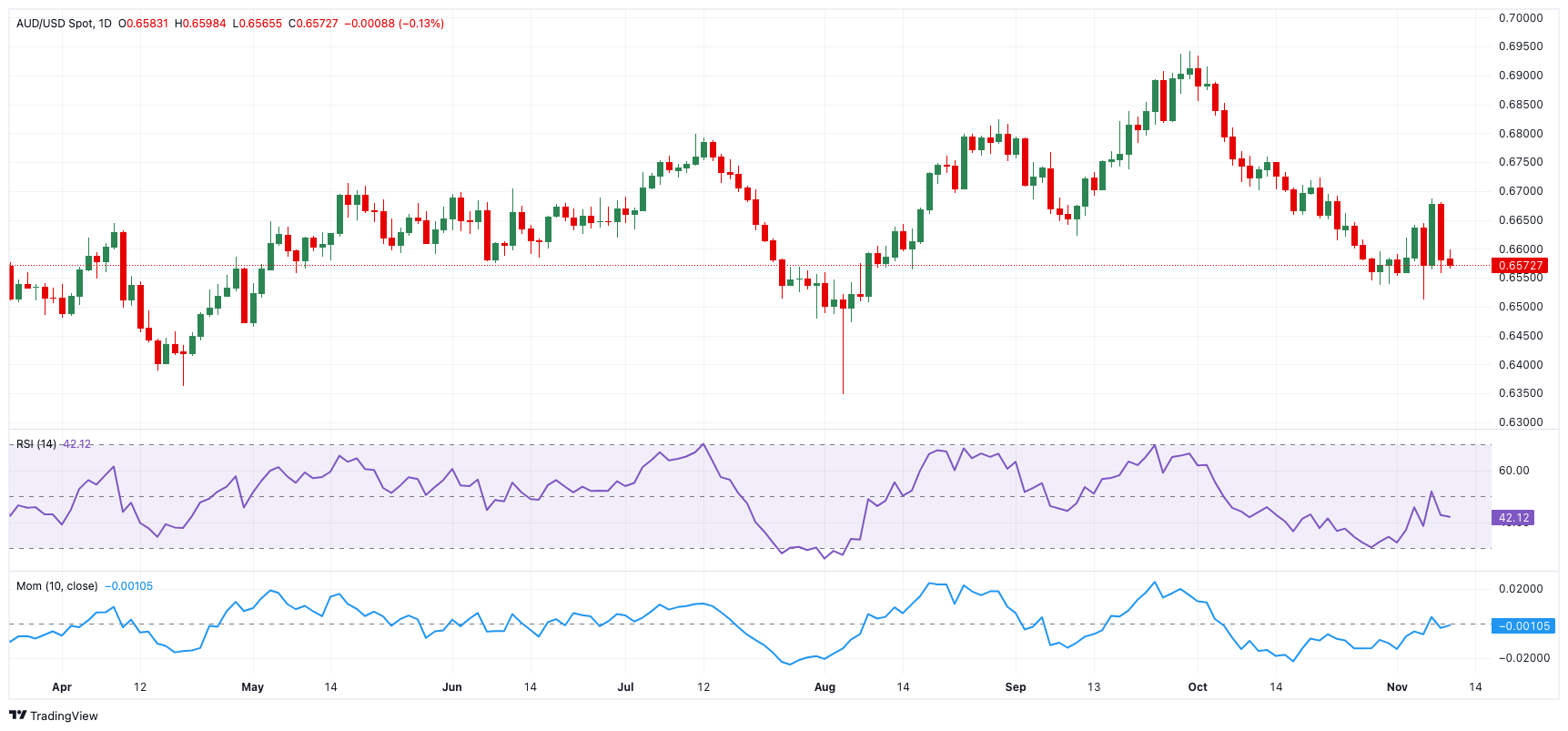- AUD/USD added to Friday’s pullback and broke below 0.6600 once again.
- The “Trump trade” continued to underpin the move higher in the US Dollar.
- Chinese inflation figures lost further impulse in October.
The US Dollar added to Friday’s gains and kicked off the new trading week on a robust note, helped by the continuation of the so-dubbed “Trump trade”, lifting the US Dollar Index (DXY) to new four-month highs around 105.70.
In this environment, the Australian Dollar (AUD) remained well on the defensive, returning to the sub-0.6600 region and extending the trade below the critical 200-day SMA (0.6629), at the same time leaving the door open to extra losses in the short-term horizon.
Additionally, the Aussie Dollar derived extra downward pressure from further retracement in copper prices vs. marginal moves around iron ore price.
Also, on the negatives for AUD, weekend data from China revealed consumer prices rose at the slowest pace in four months in October, with deflationary pressures deepening on the producer side, underlining the country’s ongoing economic challenges.
The above added to rising scepticism surrounding the implementation and ultimate effectiveness of the recently announced stimulus measures in China.
Back to monetary policy, the Reserve Bank of Australia (RBA) held rates steady at 4.35% at its meeting on November 5, as expected, while signalling a neutral stance on policy. The RBA noted inflation is gradually approaching its 2-3% target, though it lowered its growth forecast slightly.
Furthermore, RBA Governor Michele Bullock, in her subsequent press conference, struck a balanced tone, implying that the current interest rate level is appropriate for now. Markets anticipate a potential rate cut in May 2025, positioning the RBA as one of the last G10 central banks to consider easing.
Australia's latest inflation figures showed a cooling trend, with September's CPI slowing to 2.1% and the Q3 annual rate at 2.8%.
Looking ahead, while possible Federal Reserve (Fed) rate cuts may boost AUD/USD, the inflationary effects on the economy expected under a Trump administration should keep the Greenback well supported and hence limit the pair’s upside potential. In the same line persistent lingering concerns about China's economic outlook should keep AUD under the microscope.
On another front, speculators remained net buyers of the Australian Dollar in the week to November 5, according to the latest CFTC report. The weekly move, however, came amidst the fourth consecutive pullback in open interest.
AUD/USD daily chart
AUD/USD short-term technical outlook
On the upside, the AUD/USD should hit its initial resistance at the November peak of 0.6687 (November 7), an area reinforced by the provisional 100-day SMA. Further up emerges the interim 55-day SMA at 0.6720, before reaching the 2024 high of 0.6942 (September 30).
If sellers take control, the next point of contention is the November low of 0.6511 (November 6), which comes before the 2024 low of 0.6347 (August 5).
The four-hour chart shows a speedy return of the bearish trend. That being said, the initial support comes at 0.6558 prior to 0.6511. On the upside, immediate hurdle aligns at the 100-SMA at 0.6616 ahead of 0.6687. The RSI eased to around 42.
Information on these pages contains forward-looking statements that involve risks and uncertainties. Markets and instruments profiled on this page are for informational purposes only and should not in any way come across as a recommendation to buy or sell in these assets. You should do your own thorough research before making any investment decisions. FXStreet does not in any way guarantee that this information is free from mistakes, errors, or material misstatements. It also does not guarantee that this information is of a timely nature. Investing in Open Markets involves a great deal of risk, including the loss of all or a portion of your investment, as well as emotional distress. All risks, losses and costs associated with investing, including total loss of principal, are your responsibility. The views and opinions expressed in this article are those of the authors and do not necessarily reflect the official policy or position of FXStreet nor its advertisers. The author will not be held responsible for information that is found at the end of links posted on this page.
If not otherwise explicitly mentioned in the body of the article, at the time of writing, the author has no position in any stock mentioned in this article and no business relationship with any company mentioned. The author has not received compensation for writing this article, other than from FXStreet.
FXStreet and the author do not provide personalized recommendations. The author makes no representations as to the accuracy, completeness, or suitability of this information. FXStreet and the author will not be liable for any errors, omissions or any losses, injuries or damages arising from this information and its display or use. Errors and omissions excepted.
The author and FXStreet are not registered investment advisors and nothing in this article is intended to be investment advice.
Recommended Content
Editors’ Picks

EUR/USD treads water just above 1.0400 post-US data
Another sign of the good health of the US economy came in response to firm flash US Manufacturing and Services PMIs, which in turn reinforced further the already strong performance of the US Dollar, relegating EUR/USD to the 1.0400 neighbourhood on Friday.

GBP/USD remains depressed near 1.2520 on stronger Dollar
Poor results from the UK docket kept the British pound on the back foot on Thursday, hovering around the low-1.2500s in a context of generalized weakness in the risk-linked galaxy vs. another outstanding day in the Greenback.

Gold keeps the bid bias unchanged near $2,700
Persistent safe haven demand continues to prop up the march north in Gold prices so far on Friday, hitting new two-week tops past the key $2,700 mark per troy ounce despite extra strength in the Greenback and mixed US yields.

Geopolitics back on the radar
Rising tensions between Russia and Ukraine caused renewed unease in the markets this week. Putin signed an amendment to Russian nuclear doctrine, which allows Russia to use nuclear weapons for retaliating against strikes carried out with conventional weapons.

Eurozone PMI sounds the alarm about growth once more
The composite PMI dropped from 50 to 48.1, once more stressing growth concerns for the eurozone. Hard data has actually come in better than expected recently – so ahead of the December meeting, the ECB has to figure out whether this is the PMI crying wolf or whether it should take this signal seriously. We think it’s the latter.

Best Forex Brokers with Low Spreads
VERIFIED Low spreads are crucial for reducing trading costs. Explore top Forex brokers offering competitive spreads and high leverage. Compare options for EUR/USD, GBP/USD, USD/JPY, and Gold.


